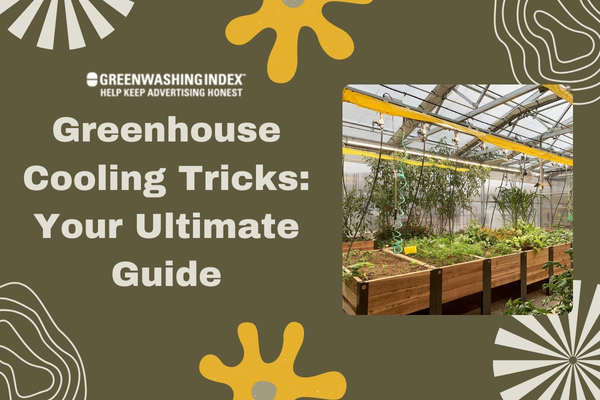Have you ever walked into a greenhouse and felt the blast of sticky heat? It’s like Mother Nature turned the thermostat way up! But hold on, aren’t we supposed to be in control here?
Keeping a greenhouse cool is essential but can seem a tricky task. Don’t worry, though; I’m here to demystify Greenhouse cooling for you in simple terms. If your plants could talk, they’d probably ask for some shades and a nice breeze, so let’s figure out how to give them just that.
Keeping your greenhouse at the right temperature is not about installing big, fancy systems all the time. Sometimes, it’s about working with what you’ve got.
Start simple: use shade cloths or whitewash on the roof to block out some sun; open windows or vents for airflow; splash water around – it cools as it evaporates!
These small changes make a big difference. If you’re ready for an upgrade, fans and evaporative coolers are waiting in the wings. But hey, before diving in deep pockets, first, let’s explore all our options, shall we?
What is Greenhouse Cooling?
When I think about growing plants, keeping them in a place where they can thrive is key. That’s where the idea of a greenhouse comes in.
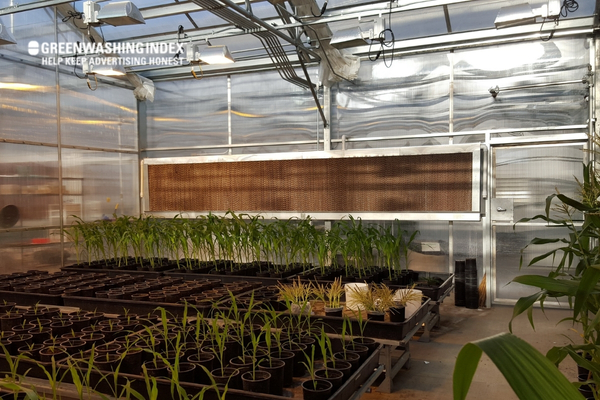
Greenhouse cooling doesn’t mean just opening a window or turning on a regular fan; it’s about cleverly managing heat so that my leafy friends don’t break into a sweat! You see, when sunlight shines through the greenhouse glass or plastic walls, it warms up everything inside. Plants love this warmth to an extent, but too much heat can harm them—or even dry them out.
Now, how exactly does greenhouse cooling differ from simply adjusting your room’s thermostat?
Well, think of it this way: houses usually have insulated walls and ways to control temperature easily – maybe through air conditioning or heating systems. But greenhouses are mostly made up of transparent materials that let sunlight flood in nonstop.
Greenhouse cooling is the art of keeping this plant paradise at just the right temperature, cool enough to keep plants healthy without taking away from the balmy conditions that make greenhouses so special for growth. It’s all part of providing an ideal environment for seedlings and crops to grow up strong and fruitful.
Efficient greenhouse cooling methods are crucial not because we want chilly plants but rather because we want happy plants. If I keep things balanced inside, cooling when necessary, I’m helping these green buddies stretch their leaves out with joy rather than droop down with heat stress.
From using shade systems that act like sunglasses for my greenhouse to bringing in fresh air or setting up water systems that take away extra heat—all these are parts of what makes greenhouse cooling unique and important. It’s not just about comfort; it’s also about giving crops what they need most: stable conditions for top-notch growth.
Ultimately, whether I’m nurturing delicate orchids or sturdy veggies for harvest—the goal is simple: help create a space where nature’s magic unfolds at its best through smart greenhouse cooling.
Also Read: Industrial Carbon Footprint Reduction: Proven Strategies
Key Strategies for Effective Greenhouse Cooling
When I’m talking about greenhouse cooling, it’s all about keeping the space inside the greenhouse at a certain cool temperature. See, plants can get too hot just like we do, and when they do, they might not grow as well. So, I’ve got to use some solid plans to keep my greenhouse chill.
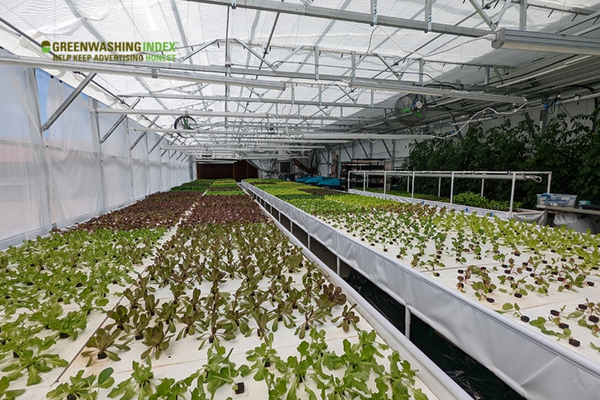
Passive vs Active Cooling Systems
Alright, let’s dive into two big ways of cooling a greenhouse: passive and active cooling systems.
Passive cooling systems are what you call doing things without using up power. Think of opening windows or using shade cloth. This way, it doesn’t need machines or any electronic gadgets to work; it’s all about designing the greenhouse smartly so that nature does most of the hard work.
On the flip side, there are active cooling systems, which are like your air conditioners at home. They need electricity or fuel to run fans or coolers that drop the temperature inside.
The big difference between these two? One uses energy from nature (that’s free!), and one needs actual power (that’s not so free!). Passive methods tend to be cheaper in the long run ’cause you ain’t paying for electricity all the time.
Shade Cloths and Their Role in Temperature Control
Now for shade cloths – these bad boys are super important in greenhouse cooling. Imagine wearing a hat in summer; just like how it protects you from sunburns on your head, shade cloth guards plants against too much sun heat.
Putting up shade cloths over your greenhouse can really cut down on how hot it gets inside during those sunny days. It’s all about picking out the right type ’cause some let through more light than others. You can’t block out everything cause plants need some sun after all – it’s their food!
So why use them? Simple.
1) They keep your leafy pals nice and cool.
2) They stop strong sunlight from scorching them.
3) By reducing heat, you save water since less will evaporate away.
Remember, though, you have to adjust these clothes depending on what weather is rolling in because if there ain’t enough sunlight hitting your plants – they aren’t going to be very happy either!
In short, Shade clothes = sunglasses for greenhouses. Cool? Cool!
Also Read: Pistachio Shells Compostability: Breaking the Myths
Ventilation: The Lifeline for Proper Greenhouse Temperatures
When I talk about greenhouse cooling, ventilation is like a lifeline. It’s super important because it lets fresh air come in and gets the hot air out. This keeps plants happy in just the right temps.
Natural Ventilation Techniques
Now, let me tell you about natural ways to keep your greenhouse at nice cool temperatures without using fancy tools:
- Open those Vents: Make sure your greenhouse has vents at the top and sides. Why? Hot air likes to go up, so when you open those top vents, the warm air escapes. Side vents let cool air come inside.
- Roll-Up Side Panels: Some greenhouses have sides that you can roll up like sleeves! Pull them up and allow a breeze to waft through. It’s simple but super effective.
- Door Opening: Don’t overlook this easy trick – keep your doors open during the day for an extra doorway of fresh air to mix in.
- Shade Cloth Magic: Covering parts of your greenhouse with shade cloths isn’t just for blocking some sun; it actually helps lower the temperature by keeping things less sunny inside.
- Strategic Planting: Did you know plants can help too? Plant taller ones or even climb vines near vents — they’ll act as natural fans by pulling cooler outside air into your hot greenhouse.
These are wallet-friendly suggestions for efficient greenhouse cooling that use what Mother Nature gives us.
Installing Exhaust Fans
Sometimes, though, nature needs a bit of help, which is where exhaust fans come into play:
- When to Consider Fans: If using all the natural methods I talked about still leaves your plants swooning from heat, that’s when exhaust fans step in—they’re perfect for getting lots more air movement happening.
- Choosing Your Fan: Not just any fan will do. Pick one that’s right for your size of a greenhouse—it should say how many cubic feet per minute (CFM) it moves on the box or description.
- Location Matters: Put those fans high up on one end of your greenhouse and make sure they face outdoors so they can shoot all that stifling hot air outside where it belongs.
- Pair with Intake Vents: When installing fans, add intake vents across from them at plant level on the opposite wall. That way, cooler outdoor air gets pulled across all your precious greens evenly before heading out again.
Exhaust fans are really good helpers for optimal temperature control in greenhouses when those hotter days roll around.
So there we have it! A couple of ways anyone can create efficient cooling methods for greenhouses. Just remember ventilation is key, whether it’s letting Mother Nature do her thing or giving her a nudge with some well-placed tech boosts!
Also Read: Recyclability of Milk Cartons: Is It Possible or Not?
Technological Solutions for Precise Temperature Management
When I think about keeping my greenhouse cool, I know that precise temperature management is key. There are some high-tech tools that help do this job well.
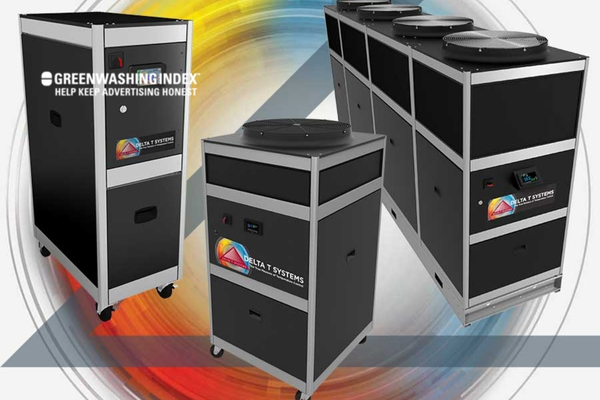
Evaporative Coolers Explained
Here’s a detailed look at evaporative coolers:
- What They Are: Imagine a sponge soaked in water. If you blow air over it, it feels cooler, right? That’s basically what an evaporative cooler does in a greenhouse.
- How They Work: Evaporative coolers pull hot air from outside through wet pads. As the air passes through these pads, the water evaporates and cools down the air inside the greenhouse.
- Best Climate: These coolers are champions for places that are more like deserts—not too sticky or wet. Think hot and dry!
- Efficient Cooling: They’re part of what you’d call “holistic” cooling. This means they’re one piece of a larger cooling puzzle, working with other methods to keep plants happy.
Using evaporative coolers means paying attention to humidity levels too, because they add moisture to the air as they chill it down.
High-Tech Monitoring Systems
Moving on to monitoring systems, here’s what makes them so smart:
- Modern Sensors: These little gadgets measure stuff like temperature and humidity inside your greenhouse every second of every day.
- Real-Time Updates: Imagine having a tiny helper in your pocket who tells you how warm or cool it is in your greenhouse at any moment—that’s what these sensors do via your phone or computer.
- Automatic Adjustments: Some systems can even tell fans or shades when to turn on and off based on set rules you give them beforehand.
These high-tech helpers make sure your plants stay in their comfort zone without you needing to check on them all day long.
Both these technological solutions—an evaporator cooler for adding chill and monitoring systems for super-smart watching—are big bits of help when I focus on greenhouse cooling.
With careful planning and these advanced tools, keeping my green pals comfy even when it’s blazing outside is totally possible.
Also Read: Greenhouse Gardening: Your Ultimate Guide to Aquaponics
DIY Tips For Reducing Heat In Your Greenhouse
When the sun beats down, my greenhouse can feel like a sauna. It’s important for plant health to manage the heat. So, I want to share a simple and cost-effective way I found to help cool my greenhouse: building a heat sink storage system.
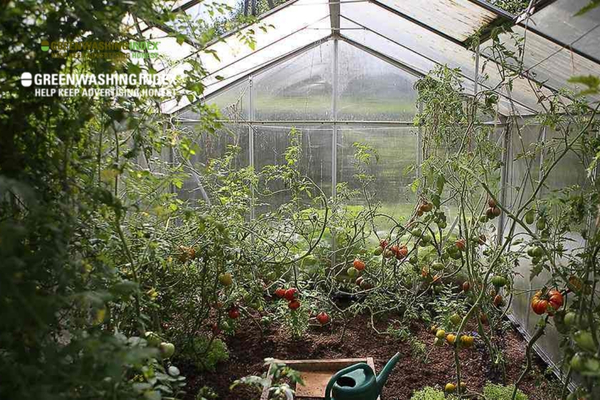
Building A Heat Sink Storage System
A heat sink storage system absorbs extra warmth during the day and releases it slowly when it gets cooler at night. It helps stabilize the temperature inside your greenhouse. Here’s how you can build one yourself:
- Choose Your Location: First, pick a spot in your greenhouse that’s out of direct sunlight but near your plants.
- Gather Materials: You’ll need some basic stuff like:
- Large barrels or buckets (preferably black as they absorb more heat)
- Rocks or gravel
- Water
- Thermometer (to monitor temperatures)
- Prepare Your Barrels: Clean your barrels nicely so there’s nothing bad left that could harm your plants.
- Fill With Rocks and Water: Put rocks or gravel in the bottom of each barrel—this is where you start making your “heat bank.” Then, fill up the barrels with water just below the top.
- Position The Barrels: Place these filled barrels in their chosen location within the greenhouse—remember, not directly under sunlight but close enough to your plants.
- Monitor Temperature Changes: Use a thermometer to keep an eye on how hot or cold it is inside throughout different times of day and night.
Here’s what happens: during daytime, when it’s hot outside, these water-filled barrels soak up that extra heat from around them—it gets stored in both rocks below and in water above.
When night rolls around and the outside drops, all that stored warmth starts seeping back out into your greenhouse air, which gives off gentle, consistent warming for quite some hours into nighttime—it’s like having a natural thermostat!
It might take some tweaking—the size of your barrels or quantity of water might change based on how big or sunny your greenhouse is—but once you’ve got this setup right, it does wonders for cooling things down without you having to do much at all!
Plus, since it uses such basic materials as buckets and rocks, this way of cooling doesn’t hit hard on my wallet either!
Frequently Encountered Challenges And Solutions In Greenhouse Cooling
When I run into trouble cooling my greenhouse, it’s often due to simple mistakes that many of us make. Over the years, I’ve learned how to spot these errors and, more importantly, how to fix them.
Overcoming Common Mistakes in Greenhouse Heating and Cooling Cycles
Not Monitoring the Temperature Regularly: It’s easy to set up the greenhouse and then forget about regular checks. Without keeping an eye on the temperature, it can spike, causing harm to the plants.
Solution: The key is to check your greenhouse’s temperature at least twice a day – once in the morning and once in late afternoon.
Ignoring Ventilation Needs: Sometimes, people think just opening the door will be enough for airflow. Sadly, that’s not often true. Solution: To ensure efficient greenhouse cooling, install proper vents or fans that create cross-ventilation.
Overlooking Humidity Levels: Just as too much heat can stress plants out, so can incorrect humidity levels.
Solution: Use a hygrometer – a tool for measuring humidity – to monitor moisture in the air and make adjustments as needed.
Neglecting Shade Systems: Not all plants love direct sunlight all day long; some prefer shade. Ignoring this fact means you could accidentally cook your plants!
Solution: Use shade cloths or plant taller crops strategically to cast a shadow over more sensitive ones when planning for cooling methods for greenhouses.
Forgetting Insulation During Cooler Months: In trying so hard not to overheat my greenhouse during summer, I’ve sometimes forgotten about keeping warmth in during cooler months. This mistake can lead to equally damaging temp swings!
Solution: Make sure you have insulating materials like bubble wrap or special greenhouse plastic that helps retain heat when needed.
By sidestepping these common mistakes with good practices for temperature control in greenhouses, like constant temperature checks, solid ventilation plans, humidity controls, suitable shading strategies, and season-wise insulation tactics, we can maintain an ideal environment inside our greenhouses without much hassle!
Also Read: Greenhouse Gardening: Your Ultimate Guide to Aquaponics
Long-term Considerations When Planning Your Greenhouse Environment
When I think about keeping my greenhouse cool, I know it’s not just about today or tomorrow. It’s about making sure my plants have a good place to grow for many years. That means I have to plan the right way from the start.
Insulation Choices That Matter
Insulation is like a cozy blanket for your greenhouse, but it doesn’t keep it warm—it helps keep it cool when it’s hot outside. Good insulation stops the heat from getting in so easily. Here are some things I consider when picking out insulation that works well and lasts long:
- Reflective Insulation: This type shines sunlight away from your greenhouse, so less heat gets inside.
- Bubble-wrap Insulation: You might know this as the stuff you pop for fun, but it also does a great job of keeping the heat out.
- Polystyrene Sheets: These are hard foam boards that can really block the hot air.
These choices depend on how much money I can spend and what my weather is usually like. If you have a little extra to spend, reflective insulation and polystyrene sheets work great!
If you need to stick to a budget, bubble wrap is still pretty good at keeping things cool.
Each one has its own way of making sure that greenhouse cooling isn’t too hard on your wallet in the long run:
- Reflective Insulation:
- Benefits: Reflects sun; very effective.
- Good For: Hot areas with lots of sun.
- Budget Tip: You can use radiant barriers, which are more affordable than full panels.
- Bubble-wrap Insulation:
- Benefits: Easy to find; simple to put up.
- Good For: Anyone looking to save some cash.
- Budget Tip: Reuse packaging bubble wrap if you can ensure it’s clean and clear!
- Polystyrene Sheets:
- Benefits: Strong and sturdy; blocks heat well.
- Good For: Places with strong winds or storms because they’re tough.
By taking care of which materials I choose for insulation, I’m fixing two important things at once—I keep my plants happy with temperature control in greenhouses, and I save money throughout all those years ahead.
And remember! Your choice should mix well with other cooling methods for greenhouses, like shade systems or fans—this combo prepares your green paradise not just for summer but for any day under that bright sun!
FAQs
What are some cost-effective ways to achieve better greenhouse cooling?
Some handy and cheap ways to cool down a greenhouse include using shade cloths, making sure there’s good airflow with vents or fans, and sometimes watering plants in the morning so the space stays cooler during the day.
How do I determine if my current greenhouse cooling system is adequate?
Check the temperature inside your greenhouse during different times of the day. If plants are happy and not wilting, and temperatures stay within their comfort zones, your cooling method is likely doing okay. If not, you might need to think about improving it.
Can greenhouse cooling still be achieved during extreme heat waves?
Even in really hot weather, you can cool your greenhouse by adding more shade, increasing air movement with fans, and making sure there’s plenty of water for both plants and evaporative systems that rely on moisture to help cool things down.
Conclusion
In wrapping up our journey through the world of greenhouse cooling, we can say that mastering the balance of temperature is key to a thriving indoor garden. Paying close attention to the cooling needs of your plants not only ensures their health but also increases their productivity.
Whether opting for natural methods like strategic ventilation or investing in high-tech solutions like monitoring systems, understanding and applying these concepts effectively can lead to successful and sustainable greenhouse management.
From using shade cloths to installing evaporative coolers or creating DIY heat sinks, there are numerous ways to keep temperatures in check. It’s all about finding what works best for your setup. Remember that while the initial effort might seem daunting, the payoff in plant health and yield is truly worth it.

